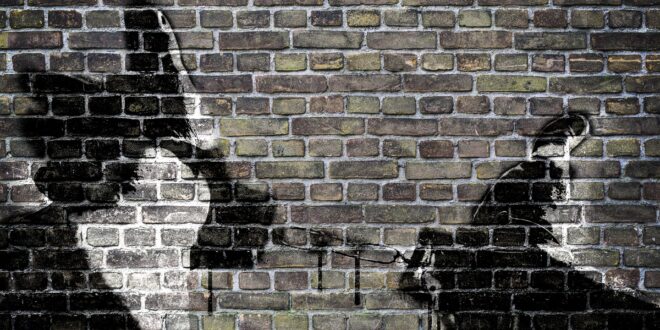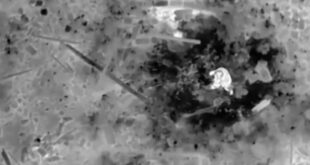by Susan Katz Keating
The man in the video cowers on the floor of a dingy room, in the spot where two brick walls converge. Filthy and nearly naked, this unidentified captive faces the camera while shielding his head with his hand.
Unlike other conflict-atrocity videos currently making the rounds, this one has not sparked outrage on social media – perhaps because it is too gruesome even for a proud perp to post. It arrived directly in my inbox, from several friends who said they got it from someone in Ukraine. They asked if, in light of my research on POWs and captives, I could shed light on what was going on, besides the obvious.
“Heads up,” one friend warned. “It’s like what happened with Hector and Achilles, only real. With a little McDonald’s thrown in for nuance.”

The reference to the Trojan War got my attention. When I was a schoolgirl studying Classics, I translated ancient poetry about a story from Greek mythology, where the warrior Achilles stabs to death his enemy Hector, ties him to a chariot, and drags his body around the walls of Troy. For three days.
Here in the modern world, dead or captured enemies don’t get dragged behind chariots for days on end; but sometimes, if the perp has a certain mindset, they do get brutalized in front of an audience. When that happens, the episodes are not recounted in epic poetry. They go straight to video. We saw this in 2002, when Islamic militants in Pakistan videotaped themselves beheading journalist Daniel Pearl; and in 2014, when ISIS killers recorded the murders of journalists James Foley and Steven Sotloff.
The current videos are set in places like Haiti, Iran, Mexico – or Ukraine, the setting of the so-called Tik Tok War.
One infamous vid shows the murder of a Ukrainian soldier as he stands unarmed in a ditch. The man has been identified as two people: Tymofiy Shadura, who went missing from Ukraine’s 30th Separate Mechanized Brigade on Feb. 3 near Bakhmut; and Oleksandr Matsiyevsky, a sniper from the 163rd Battalion of the 119th Territorial Defense Brigade of Chernihiv Oblast.
In the video, “The Smoking Prisoner” stands in a shallow trench while holding a cigarette between his lips. He takes a drag and says, “Glory to Ukraine.” He immediately is shot. As he slumps to the ground, a voice says in Russian: “Die bi*ch.”
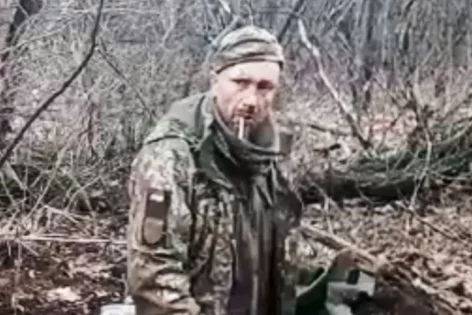
Another video surfaced on Telegram, depicting a man who supposedly deserted from the Wagner paramilitary group. The man is taped to a wall, and is pummeled to death with a sledgehammer. The Wagner group’s founder, Yevgeny Prigozhin, afterwards offered commentary as if from a villainous film critic; he praised the director, but said the title should have been, “A Dog Receives a Dog’s Death.”
Those are the types of mini-films that go viral. Others quietly are circulated, such as the one that arrived in my inbox. I call it The Cornered Man. The video is so gruesome I will not share it here or on social media.
The sequence unfolds as if it might be a ransom video, or a proof of life for a prisoner exchange. Perhaps that’s what the captors wanted the prisoner to think.
This is where my friend’s comment regarding the nuance of McDonald’s comes in.
In the video, what appears to be a clean and bright McDonald’s wrapper is tucked beneath the prisoner’s knee. A clear plastic bottle lays nearby on its side, dripping water. The captors possibly had fed the prisoner. In any case, they hadn’t starved him; he is not emaciated. The captors perhaps have been softening him up, getting him to talk.
When did this occur; who is the man; and where was he held?
The “when” part is both narrow and broad. The incident surely occurs following Feb 24, 2022, when Russian President Vladimir Putin sent his forces to invade Ukraine; but that limited span leaves few breadcrumbs leading to a precise date.
Who is the man? For now, he only can be described. The prisoner’s dark hair is neatly trimmed. His face is covered in stubble that is past being a “morning shadow,” but not yet a beard. His fingernails are clean. On his right pinky finger, he wears a ring; on his wrist, the type of reddish string bracelet that is worn for protection. The man has a tattoo from a Ukrainian military unit. He likely was captured within a few days of appearing on video; my guess is, not from the battlefield.
As for place, a few things can be deduced from the makeshift prison cell.
A wire runs down one dank-seeming, painted brick wall, and atop the carpeted floor. The room is or was connected to the outside world in some fashion. The floor covering is filthy, but the grime doesn’t entirely block out a flower pattern. It isn’t clear whether this is a carpet or a rug, but at some point, someone intended for people to use the room.
The food wrapper is new and spotless. My contacts in Ukraine tell me the McDonald’s packaging there is similar to that in the States, signaling that a hamburger or fries had been brought into the bleak makeshift prison cell. A search of fast food outlets in Ukraine shows that several McDonald’s restaurants are open in Kyiv and Lviv, while others are located in the eastern parts of the country, including Kharkiv and Kremenchuk. A company website gives hours for a site in Bucha. The video may have been taken within driving distance of one of those cities.
A rep from McDonald’s offered no insights, other than to apologize if I had a poor experience at one of their restaurants in Ukraine.
Because the wrapper is oddly positioned beneath the prisoner’s knee, and because the bottle is spilling its contents, it looks as if the man has been interrupted while eating, or shortly afterwards. Perhaps he dropped the bottle or knocked it over while scooting away. His body language and eyes show that he is afraid of the person standing above him.
READ MORE from publisher Susan Katz Keating on crime
The prisoner speaks desperately to the camera – too rapidly for an outsider to decipher, only to recognize that his accent is from Western Ukraine. The captive gestures emphatically.
A pistol emerges from behind the camera. The pistol points down toward the captive.
A shadow depicts a new figure offscreen, moving toward The Cornered Man.
The prisoner grows more frantic. He speaks in urgent, pleading tones, as if trying to explain something before he runs out of time.
Watching this, I nodded to myself. In the ancient poem about the Trojan War, Hector, too, is filled with fear, like a “cringing dove,” while Achilles closes in. The cornered Hector runs out of options, and realizes that he will be killed. He pleads for Achilles to send his corpse to his family for a proper burial.
Achilles responds in a way that surely would have charmed Prigozhin: “Beg no more, you fawning dog…The dogs and birds will rend you—blood and bone!” Achilles then plunges his spear into Hector’s throat.
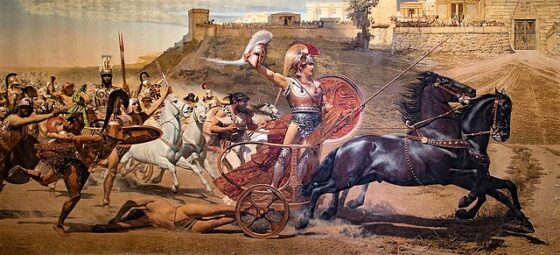
In The Cornered Man video, the half-naked prisoner arrives at his own moment of clarity. He stops pleading. He looks his captor straight on. He lifts his chin, speaking clearly in Ukrainian.
“Victory -“
POP! The captor shoots him. The prisoner collapses.
At that point, the shooter has won. The prisoner is dead, and nothing more can be done to him – or so it would seem. But the shooting triggers a manic burst of violence of a type that has been known through the centuries.
In the ancient poem, as soon as Achilles stabs Hector, other soldiers come forward. They plunge their swords into the lifeless Hector.
In The Cornered Man video, others similarly pile on. As the prisoner’s dead body lays slumped on the floor, a second hand appears, holding a larger caliber gun. This person shoots the dead man at close range.
A third hand appears, holding a pistol.
The shooters step over the bright food package, as if it’s not there. As if it has no meaning, and symbolizes nothing related to nurturing, sustenance, nor life.
The shooters close in on their prey. They rip into him, over and over, while his blood pours out in cascades of deep red. The shooters fire at least 25 rounds into the dead prisoner.
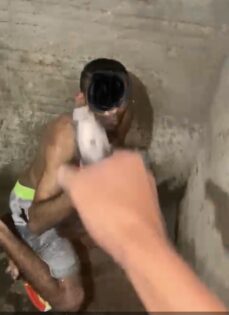
When I was done catching my breath from watching this gruesome scene, I spoke to one of the friends who sent me the video. We talked about what it meant, and how to make sense of it.
My own inner film critic fixated on the bright red food wrapper; how it injected a measure of normalcy, a token of fellowship, and ultimately false comfort into a barbarous episode.
But – like the sledgehammer video before it – this is not a creative work to be mined for symbolism. This is a record of events, with presence and purpose.
At a basic level, The Cornered Man and similar videos show that savagery is alive and thriving in the world. The videos also send a message: This is what happens to our enemies. They inspire payback. Ukrainian soldier Tymofiy Shadura’s commanders said as much when they warned: “Revenge will be inevitable.”
The videos additionally are evidence. According to the Geneva Convention on the Treatment of Prisoners of War, POWs must be guaranteed life and humane conditions of detention. Executions or ill-treatment of captives are considered war crimes. The prisoners’ people know this.
“Even the war has its own laws,” said Ukraine’s prosecutor general, Andriy Kostin, in statements on Twitter and Telegram about the Smoking Prisoner footage. “Sooner or later, there will be punishment.”
The videos surely will feature in war crime tribunals, as will witness testimony from anyone who isn’t afraid to talk. At some point, a defense counsel likely will argue that war is war, and that even the mythic Achilles committed an atrocity.
But there is a difference.
Achilles at some point relented. His fury abated.
“Now I am making an end of my anger,” Achilles said in the ancient poem. “It does not become me, unrelentingly to rage on.” Chastened, he returned Hector’s body to his father to bury.
I am not aware if the recent prisoner-killers repented. I have not seen any followup videos expressing regret. The Smoking Prisoner cameraman posted the vid as a one and only statement on what his comrades did to the unarmed soldier in the trench. The Cornered Man cameraman did not immediately delete his murder video, if at all, which is why it went into circulation. Both videos appear to demonstrate a pride of work.
Even Yevgeny Prigozhin, though, seemed to draw a distinction between killing a deserter and shooting an unarmed captive. There is no evidence to link Wagner Group fighters with the Smoking Prisoner incident, Prigozhin said. But if evidence emerges, “we will certainly look into it in detail,” he said.
One pro-Russian writer who has plenty of criticism for all sides in the war on Ukraine offered an apologia of sorts for the Smoking Prisoner execution.
“The real culprit for this incident is the Russian MoD’s policy of releasing some of the most heinous Ukrainian death squad members in dubious and uneven prisoner swaps,” wrote the acerbic essayist who calls himself Rolo Slavskiy.
And, while Slavskiy’s argument is a tough sell on many levels, he likely is correct when he predicts that “the war is going to get nastier and prisoners are going to start dying more often.”
And the attending videos will continue to appear privately via e-message, or overtly on social media feeds.
The killers’ predecessor, Achilles, was viewed by some as a merciless butcher, and by others as a hero. He often is cast as a courageous warrior who also was flawed, and who sought redemption.
For the modern Tik Tok assassins, there is nothing heroic to counterbalance their savagery, and no redemption. They hide their identities while neglecting to name their targets, displaying cruel brutality as casually as they would step on the remains of a prisoner’s last meal.
Susan Katz Keating is publisher and editor in chief of Soldier of Fortune.
 Soldier of Fortune Magazine The Journal of Professional Adventurers
Soldier of Fortune Magazine The Journal of Professional Adventurers


